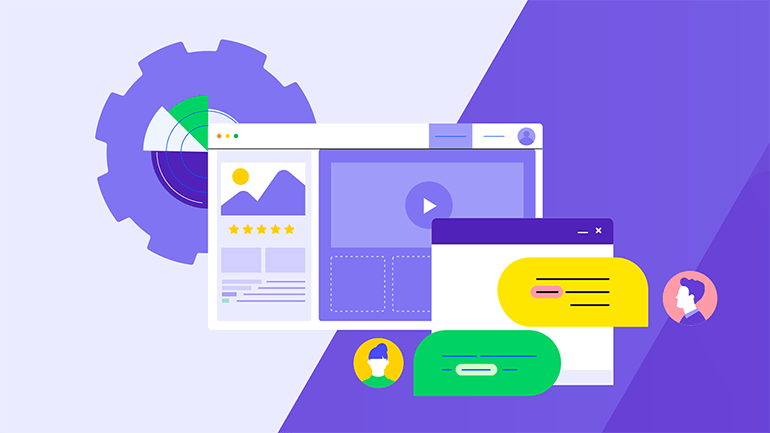How an Intuitive CMS Empowers Marketing and Reduces IT Requests

With an intuitive CMS, marketing teams can own the content and IT can focus on higher impact priorities.
Progress Sitefinity is a robust content management system (CMS) designed to simplify website development while enabling sophisticated digital experiences.
For many organizations, the relationship between marketing teams and IT departments has become a source of friction: marketing needs to move fast, but IT backlogs often move slower. Every content update, page creation or campaign launch becomes a ticket in an ever-growing queue, creating bottlenecks that stifle business agility.
When your CMS is user-friendly with a shallow learning curve, it transforms this dynamic entirely. Marketing teams can take ownership of their content, developers can focus on strategic technical initiatives and the entire organization benefits from faster time-to-market and improved operational efficiency.
For more details on what Progress Sitefinity is and how it works, check out the previous article—What is Progress Sitefinity and How Does It Work?
The IT Bottleneck Problem
Before diving into how Sitefinity addresses these challenges, it’s important to understand the scope of the problem. In many organizations, the content management workflow often looks something like this:
- Marketing team identifies a need for new content or page updates.
- Request gets submitted to IT as a ticket or work order.
- IT team reviews the request and prioritizes it against other technical work.
- Developer eventually gets assigned to make the changes.
- Changes get implemented, tested and deployed.
- Marketing team reviews the results and requests revisions.
- The cycle repeats until the content meets requirements.
This process, while enabling quality control, can stretch simple content updates into week-long projects. Meanwhile, competitive opportunities pass by, seasonal campaigns miss their windows and marketing teams become increasingly frustrated with their inability to respond quickly to market conditions.
The Hidden Costs
The impact extends beyond just delayed campaigns. When skilled developers spend time updating hero images, adjusting contact forms or publishing blog posts, organizations face several hidden costs:
- Resource misallocation: Technical talent gets diverted from strategic projects to routine content tasks.
- Reduced innovation: Development capacity that could be building new features instead handles maintenance.
- Marketing limitations: Teams become risk-averse, avoiding creative campaigns that might require technical changes.
- Competitive disadvantage: Slower response times mean missed opportunities and delayed market entry.
How Sitefinity Helps Eliminate Dependencies
Sitefinity CMS addresses these challenges through what we call zero-day onboarding—non-technical users are able to be productive immediately without extensive training or technical knowledge.
No-Code Page Creation
One of the most significant sources of IT requests is page creation and management for a website. In traditional CMSes, creating a new landing page for a campaign might require developer intervention to set up templates, configure layouts or implement custom functionality.
Sitefinity CMS streamlines this process to its essentials. Creating a new page requires only three inputs: a page name, URL and template selection. The platform handles all the technical complexity behind the scenes, allowing marketing team members to launch new pages in minutes rather than waiting for developer availability.
As we explored in the previous article on creating and managing pages, the process is intuitive enough that users can start creating content immediately after accessing the platform.
WYSIWYG Content Management
The rich-text editor serves as the foundation for most content creation in Sitefinity CMS. Powered by Progress Kendo UI component libraries, it provides a familiar WYSIWYG (what you see is what you get) experience that feels more like using a word processor than managing web content.
Marketing teams can format text, embed images and videos, manage layouts and even handle basic HTML, all without needing to understand the underlying technical implementation. This visual approach to content management means that what you see in the editor is exactly what visitors will see on the live site.
For a deeper dive into the rich-text editor’s capabilities, check out the article on the Sitefinity Rich-Text Editor.
Widget-Based Functionality
Complex functionality that traditionally requires custom development becomes accessible through the Sitefinity widget system. Widgets are prebuilt “components” that can be dragged and dropped onto pages to add specific functionality. Some of these pre-built widgets consist of:
- Content widgets: Display reusable content like blog posts, news items and custom content types
- Navigation widgets: Add website navigation, language selectors and content archives
- Search widgets: Implement search boxes and display search results
- User account widgets: Enable user registration, login functionality and profile management
- Email campaign widgets: Add subscription and unsubscribe forms for newsletters
- And a lot more
This widget-based approach means that sophisticated web experiences can be built through visual configuration rather than coding.
And if a specific widget isn’t already available, with the Sitefinity MCP (Model Context Protocol) server, teams can create new widgets with minimal coding.
Template System for Consistency
While empowering marketing teams with content creation capabilities, Sitefinity CMS maintains design consistency through its robust template system. Page templates serve as blueprints that define structure, styling and available functionality for different page types.
This approach provides the perfect balance: Marketing teams get the creative freedom to develop content and messaging, while the underlying template framework enables brand consistency and professional presentation. Templates can be created by developers once and then used by marketing teams indefinitely.
Learn more about leveraging templates effectively in this guide to exploring page templates.
Smaller page chunks can also be templatized with section presets, available in both ASP.NET Core section presets and Next.js section presets.
Self-Service Data Collection
Forms represent another common source of IT requests. Whether capturing contact information, conducting surveys or gathering feedback, forms traditionally require developer intervention to set up, style and configure.
The Sitefinity Forms module empowers marketing teams to create and manage forms independently. The drag-and-drop form builder allows users to add fields, configure validation rules, set up automated responses and customize styling—all without writing code.
Form data can be integrated to automatically route to CRM systems, marketing automation platforms or email lists, creating more seamless lead management workflows with less ongoing IT maintenance. This routing integration can be done manually or via Sitefinity Integration Hub, which provides a choice of 1000+ connectors and easy data flow orchestration in the form of recipes.
For detailed guidance on form creation and management, see the article on exploring forms in Sitefinity.
AI-Powered Content Creation
Modern content creation demands both speed and quality, and Sitefinity addresses this through comprehensive AI capabilities that extend far beyond simple content generation. Rather than forcing teams to learn separate AI tools or complex prompt engineering techniques, Sitefinity 15 embeds AI assistance directly into the content creation and customer experience workflow.
The AI integration includes four powerful content authoring capabilities built directly into the rich text editor:
- Compose text: Generate text from scratch based on predefined criteria such as key points, audience, tone and maximum length.
- Summarize text: Summarize longer texts based on desired keywords and length, with summaries that can be inserted into different text fields and pages. AI content tagging offers valuable SEO and content discoverability.
- Improve writing: Check grammar and language targeting a specific audience and desired tone of voice (friendly, formal or industry-specific language), and even optimize text in-line.
- Personalize text: Specify the audience or persona for text personalization when personalization is enabled for content blocks.
This integration eliminates the need for marketing teams to manage separate AI tools or learn complex prompting techniques. Content creation becomes a collaborative process between human creativity and AI efficiency, while personalization and optimization happen automatically based on real user behavior and data.
Self-Service Optimization and Testing
Traditional A/B testing and personalization often require significant IT involvement, from setting up tracking codes to implementing conditional content display. Sitefinity transforms this by putting optimization capabilities directly into marketing teams’ hands.
No-Code A/B Testing
The Sitefinity A/B testing framework allows marketing teams to create and manage A/B tests without developer intervention. The process involves creating content variations, defining success metrics and launching tests. The platform handles traffic splitting, statistical analysis and results reporting automatically.
This self-service approach to testing means optimization becomes a continuous process rather than a quarterly project. Marketing teams can respond quickly to performance data, testing new approaches and iterating based on real user behavior.
Real-Time Personalization
The platform’s personalization capabilities enable teams to create targeted experiences based on visitor behavior, demographics or custom segments. Content can be dynamized based on factors like:
- Geographic location
- Referral source
- Device type
- Time of visit
All of this happens through visual configuration tools rather than custom development.
Learn more about implementing testing and personalization strategies in the article on experimentation and personalization.
Developer-Friendly Architecture
While Sitefinity CMS excels at empowering non-technical users, it doesn’t sacrifice the flexibility and power that developers require. The platform’s architecture supports both no-code workflows and advanced customization.
Headless and Hybrid Capabilities
For organizations with complex technical requirements, Sitefinity offers headless capabilities that allow developers to use modern frameworks like React and Next.js for frontend development while maintaining the CMS for content management.
Business-Friendly Connectivity Options API-First Design
Sitefinity CMS offers options to enhance interoperability:
- APIs: Sitefinity CMS has a comprehensive API ecosystem that enables integration with existing systems and tools. Whether connecting to CRM platforms, marketing automation tools or custom applications, the platform fits into existing technology stacks rather than requiring wholesale replacement.
- Webhooks: Teams can subscribe to different Sitefinity CMS events. When that event is registered by the EventHub system, the data for the event is sent to a particular URL registered in the Webhook.
- Sitefinity Integration Hub: This middleware facilitates data integration and automation. It enables Sitefinity Cloud and Sitefinity Insight customers to easily integrate external data sources and services, quickly achieve all-round connectivity and activate event-based workflows without coding.
Wrap-up
The evolution from IT-dependent to self-service content management represents more than just a technology upgrade. It’s a fundamental shift in how organizations approach digital marketing and web management. Sitefinity CMS enables this transformation by providing intuitive tools that empower marketing teams while maintaining the technical flexibility developers require.
For organizations ready to reduce their IT backlog and empower their marketing teams, Sitefinity CMS offers a clear path forward. Whether launching a simple brochure site or building an enterprise-grade digital experience platform, the platform adapts to your needs while keeping content creation accessible to the people who understand your audience best: your marketing team.
To explore how Sitefinity CMS can transform your content management workflow, consider starting with the 14-day hosted free trial to experience the platform’s capabilities firsthand.

Hassan Djirdeh
Hassan is a senior front-end engineer and has helped build large production applications at-scale at organizations like Doordash, Instacart, and Shopify. Hassan is also a published author and course instructor where he’s helped thousands of students learn in-depth front-end engineering skills like React, Vue, TypeScript, and GraphQL.
